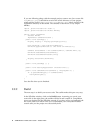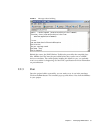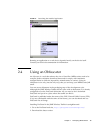
16 J2ME Wireless Toolkit User’s Guide • October 2004
3. Uncompress the proguard.jar file from the lib directory of the ProGuard
installation to the bin directory of your J2ME Wireless Toolkit installation.
Once ProGuard is installed, you can use it by choosing Project > Package > Create
Obfuscated Package.
In some cases you will need to provide a script file that controls how the obfuscator
works. If you are loading classes using Class.forName(), for example, you need
to tell ProGuard to leave the class names unchanged.
Create a script file using a text editor, then save it under the project’s main
directory. Consult the ProGuard documentation for information on script files.
Next you need to tell the toolkit how to find this file. To do this, edit
{toolkit}\wtklib\{platform}\ktools.properties, where {platform} is the name of
your underlying platform (most likely Windows or Linux). Add a line as follows:
obfuscate.script.name: scriptfile
Replace “scriptfile” with the name you used for the script file. You will need to quit
and restart KToolbar for the change to take effect.
The J2ME Wireless Toolkit also includes support for RetroGuard. If you want to use
RetroGuard, you’ll need to download it separately and change the toolkit’s
configuration.
1. Go to the RetroGuard web site, http://www.retrologic.com/retroguard-
main.html.
2. Download the latest version.
3. Extract the retroguard.jar file from downloaded zip file to the bin directory
of your J2ME Wireless Toolkit installation.
4. Edit {toolkit}\wtklib\{platform}\ktools.properties so that it uses the
RetroGuard obfuscator plug-in:
obfuscator.runner.class.name: com.sun.kvem.ktools.RunRetro
obfuscator.runner.classpath: wtklib\\ktools.zip
Retroguard will be used when you create an obfuscated package.
To switch back to ProGuard, edit the obfuscator lines in the ktools.properties
file as follows:
obfuscator.runner.class.name: com.sun.kvem.ktools.RunPro
obfuscator.runner.classpath: wtklib\\ktools.zip
If you want to use a different obfuscator, you’ll have to implement an obfusctor
plug-in yourself. See the J2ME Wireless Toolkit Basic Customization Guide for an
example of how to implement an obfuscator plug-in.


















